207 SQUADRON ROYAL AIR FORCE HISTORY
Montgomery crew : LM208 EM-M
15 Oct 1944 : Låstrup, Denmark
| On the night of 15th October 1944, 207 Squadron,
based at RAF Spilsby in Lincolnshire, was mostly stood down as
the main operation it had been tasked to take part in was
cancelled because of poor weather. Bill Chorley's Bomber Command Losses of the Second World War for 1944 records that Lancaster I LM208 EM-M (Flt Lt G H Montgomery) took off at 1838hrs and that of F/O D Ready (NG143 EM-R) at 1839hrs. They were tasked with duties over Danish waters ['Gardening' or the sowing of mines] in the Kattegat area, code named Silverthorn. In his recently published book Roy Hill says that gardening trips were seen as a 'bit of a doddle'. That night it was decided to draw lots to see which two crews should go to Denmark. His crew was lucky - they were among the losers. |
The Gardening areas around Denmark |
| Montgomery's aircraft was shot down by a night
fighter and exploded with great force, scattering debris over
a wide area of the Danish countryside near the village of
Låstrup, where all are buried in the local
churchyard, some 3km NNW of Skals [and North of
Viborg in Central Jutland]. Google Maps - Låstrup |
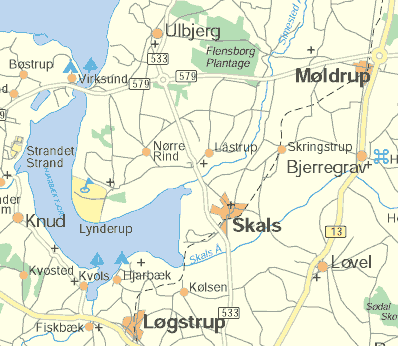 please click on the map for information about this area |
The Montgomery crew that night was:
| Pilot | Flt Lt George Henry Montgomery RAF(VR) | age 29 |
| Flight Engineer | F/Sgt James Findlay RAF(VR) | age 22 |
| Navigator | F/O Lynden Arnold McIntyre RCAF | age 29 |
| Bomb Aimer | F/O William Anderson Whitehead RCAF | age 29 |
| W/Op | Sgt James Roy Marriott RAF(VR) | age 20 |
| M/U Gunner | Sgt Albert Frederick Hall RAF(VR) | age 21 |
| Rear Gunner | Sgt James Duncan Cumming RAF(VR) | age 21 |
[Montgomery's aircraft was the successor to LL973 EM-M (P/O C J Solly) lost on the night of 21/22 June 1944: the editor's father is one of the four crew who survived].
207's luck was out that night. The crew of F/O Denis Ready in EM-R was also lost. They have no known grave and are commemorated on the Runnymede Memorial:
| Pilot | F/O Denis William Ready |
| Flight Engineer | Sgt Maurice Henry James Curtis |
| Navigator | F/O Daniel Charles Bermingham RCAF |
| Bomb Aimer | P/O Kenneth Leigh RCAF |
| W/Op | Sgt Richard Arthur Brumwell |
| M/U Gunner | F/Sgt Leslie Frank Payne |
| Rear Gunner | P/O Ervin Curtis Wilson RCAF |
A Halifax of 10 Sqn (Sqn Ldr S W Hart; MZ826 ZA-M) and a Halifax of 424
Sqn (Flt Lt R D Guild; MZ901 QB-N) were also lost the same night on
Gardening sorties in Danish waters.
There was only one survivor from these four crews.
A record of the loss of the Montgomery crew is as follows, in a translation provided to a Friend Member of 207 Squadron RAF Association, J D Cruickshank, who is a cousin of Jim Cumming, the Rear Gunner in Montgomery's aircraft :
On Sunday 15th October about 9pm a Lancaster Bomber M4M 208 [sic] crashed in the Parish of Låstrup.The plane was to have mined the Eastern Areas, but after a dogfight with a German plane it burst into flames.
The crew made the bombs safe and threw them suspended from parachutes. Large mines and heavy aircraft parts rained down on Låstrup without damaging people or property. It crashed loudly - the whole crew was killed.
On Tuesday 17th October in the afternoon the Germans buried the dead airmen without coffins in 2 graves in a special place for air disaster victims. In a report it was stated '6 men - unknown'. Following this '2 Anglo-American pilots' identified.
The matter was reported to the Foreign Office on 21st October. The Dean Kristianson and the Civil Air Authority claimed different burial places.
On 31st October in the afternoon some Germans came by order of Dr Best [the chief Nazi in Denmark] and dug the bodies up. They were reburied in 4 white coffins in the North East corner of Kirkegarden. A burial ceremony was carried out with reverence.
On the anniversary of the airmen's deaths a memorial service was held. Dean Kristianson and an English preacher [Hockin] preached before a large gathering, and the latter suggested an Earth scattering ceremony in the English custom. After 18 months another service was held. Father Kristianson preached a sermon.
Bishop Malmstam[?] erected a memorial from the grateful inhabitants of the Town. The chief administrative officer of the diocese of Buchwald and Viborg took part. Members of the RAF and 8 of the dead airmen's families and friends arrived from England.
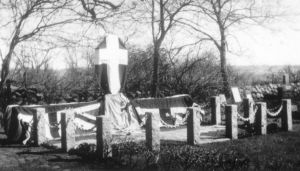
The crew memorial ready for dedication and unveiling.
An aircraft was sent from the British Legion [sic] in Copenhagen and glided over the place where the plane crashed.
An inscription was cut by the builder Nils Lambertsen of Låstrup. On 27th September 1945 the German Foreign Ministry issued a list with the names of the dead airmen.
****
Two further accounts are reproduced by permission of Mr & Mrs Thomas of Wigston, Leicestershire: Mrs Thomas was a good friend of Roy Marriott, the Wireless Operator, with whom she worked. Please be advised that it includes graphic evidence regarding the finding of the crew.
Report A
An account of the casualty at Laastrup written in the local paper by Niels C. Lambertsen, Laastrup pr. Skals
The airmen died in a sea of flames
It was Sunday evening about 9 o'clock on the 15th of October 1944. My wife had gone to bed and we four grown up people were sitting in the drawing room. We heard the spinning which we knew was from Allied aircraft (the German planes were more noisy) when a sudden burst of shots was heard just over our heads and we fell flat on the floor and expected to see the walls tumble down about us.
My wife came running and asked, what happened? Everything is on fire. She had through the windows in her dark room seen the flaming fire in the air above our house. It was only seconds until the sound had passed our house but we could still hear the shots and through the windows on the opposite side of the house we could see the flames over the cow-shed.
We ran out panic stricken in fear for the cattle. What had happened? I ran past the houses out in the field and saw that it was not my farm that was burning. About 100m further off on my neighbour's field I saw a big red furnace and round it several smaller white fires. The biggest flames went right up in the air and painted the sky red. Were there living men in that furnace? Or had they escaped by parachute in time? The small fires quickly burned down - they came from petrol or smaller parts of the aeroplane which had been strewn all over the field.
But the big furnace still burned and could be seen from far away and you could still hear the sharp sound of the ammunition exploding in the heat and some deeper detonations from the heavy ammunition and the flames sizzling. And in the grotesque scene ran some calves bellowing with fear - they had been grazing in the field when the aeroplane crashed. From all the meadows in the neighbourhood you could hear the bellowing of the frightened cattle
Very soon people came running and on bicycles. Some were frightened and stood some distance from the fire but some went quite close, still it was so hot you could not go near the aeroplane. Very soon the German soldiers arrived at the scene and people were not allowed to come near to the aeroplane but they stood at a distance and looked at the fire.
The fire died down in about an hour, but burned low for several days. Early in the morning the German guard was changed and people again arrived to look at the ruins of the aeroplane. Some German Feldengendarmerei had arrived the local policeman, the teacher and I, Niels C Lambertsen, were allowed to inspect the ruins and the field.
The aeroplane had come from west. It lay in the flying-direction but turned a bit south-east. The right wing with the two motors was lost but the left wing had only lost one motor and the end of the wing.
It looked quite strange that two men who sat back in the machine were quite unharmed by fire. They sat with their faces opposite the flying direction. It looked as if one of them had been using his machine gun because quite a lot of unexploded machine gun ammunition lay about him, some in belts and some loose. He was sitting in a low seat leaning a bit. He had long black hair, very brown in the face not pale at all but a small trace of blood from the right temple came down the face.
Some light cloth lay round his waist and shoulders. The police officer said it was a kind of life-belt. The other man who was sitting in the room beside the first one did not sit so free. The smoke blackened him and perhaps his clothes were burned a bit but he looked quite unharmed. The Germans later said that these had their papers intact and they were Canadians.
Just in front of the aeroplane we saw four people. It looked as if they had been pushed out of the hole where the right wing had been. The two of them lay quite close together, you could see the other two lying somewhat apart. One had the upper part of the body bent backwards over the legs and the last one lay on his back with arms and legs straight. You could see a hole in his temple where a bubble sat.
The clothes were burned black on both and they were burned some themselves, the skin was lost so you could see the muscles. People first thought that these two were Negroes and the police officer showed us how Negroid they were and said that the British used the Negroes in battle against white people. But later you could see that they were white people where they were not burned. The swollen lips were only on account of the heat.
How the dead bodies were interred in the field where the aeroplane crashed and how they later were transferred to the churchyard and the doubt about how many fallen airmen there were has been told before in the paper and I will not retell it.
We do not know if the aeroplane had been in an air battle or the fire started by itself. We saw it shining with fire, coming from the west, but the crew did not leave in time. Some time before it crashed in Laastrup it burst out in flames. It exploded and lost quite a lot of its parts.
One motor lay close to a house and you could see oil on the gable of the house. Two other motors lay 100m further on but on the same line, and in the same neighbourhood six sea-mines with about 20-50m between them. They were all alike and none exploded. Later it was found that they weighed 1150kg each; they were 2.5 m long and 0.5m in diameter.
An officer from the Danish Civil Airdefence told us that they were magnetic sea-mines which had to be laid in the sailing-routes, but if only one had exploded, all of Laastrup would have been wiped out. Some people told, they were air-mines, perhaps the Germans told them, they should explode in the air.
They had in the head-part an ignition mechanism which would be able to make heat of 1800 degrees Celsius and that would make it explode, and then you would get so much heat that the air in hundreds of metres radius would be driven higher up and the pressure of the air would destroy all the buildings in the area.
Some days went by then some soldiers arrived to take the bombs away and people were glad to be rid of these unwelcome neighbours. They slept better and we saw that miracles still happen.
The burning plane lost its motors and bombs quite close to the houses, others not far distant and the aeroplane itself flew right over our heads till it found a free field where it burned out without burning anybody or anything. Over the field still 3km from the village you could find smaller or bigger parts of the machine between the farmhouses. One house got a hole in the roof but that was the only damage to Laastrup.
We will think on the people who lost their lives in the plane, especially on the young Canadian who sat in his seat as if unharmed as quiet as if he slept but still with the mark of war on his face. Now he and his comrades have found a resting place in a small village church-yard which has an ocean between us and his home-country. If we may keep them the village people will care for the grave, remembering the peril they escaped out of and always decorate the grave with flowers.
One year anniversary and funeral service (15th October 1945)
The flags waved on half-mast from every house in Skals and Laastrup upon the anniversary of the British aeroplane's disaster where 7 English and Canadian airmen lost their lives. A memorial service and burial ceremony was held in Laastrup church and churchyard. The church was decorated with the most beautiful autumn flowers. Near the altar four young standard-bearers stood with Danish flags. Black veils were hanging from the flowers and candles on the altar. The church was full of people, some had to stand in the entrance hall.
After the congregation had sung A mighty fortress is our God, the Rev Dean A. Kristiansen (the local vicar) read the first verse from Psalm 46 ["God is our refuge and strength, a very present help in trouble."] and said:
"It is natural to read this verse on this day of memory. It is a year since we heard the crash of the aeroplane and saw the big fire. Nobody here will forget that night. I myself came home from a neighbouring vicarage where a young clergyman had been installed. I saw the fire from afar off and nearer home we thought it was the vicarage which burned and never has that piece of road felt so long. But luckily it was not our house. Later on we heard about the crash and how it happened. People had been panic stricken when heavy parts of the machine and big sea-mines came crashing down and the fire lit up the whole village and the neighbourhood. But no home and none of the Danes were hurt. We will this day say, Praise the Lord, he has saved us.
And we will remember the 7 young men who gave their lives and found their last resting-place in a corner of our peaceful churchyard. How their last minutes have been we do not know but it looks as if they have done their duty to the last minute. We know that the pilots have order to secure their bombs and mines when they are attacked over a friendly country and afterwards think of their own safety. These young men fell at their posts.
If we are allowed to keep them here I am sure the village-folks will keep their grave as beautiful as their own relatives would do. We have sent a copy of the plans for a memorial to England and when we get it recognised we will start making it. Our thoughts on this day go to England and Canada to the relatives of these young men who now have sorrow and we ask God to comfort and bless them all."
To Flight Lieutenant Ballingall and the Canadian chaplain the Rev Hockin, Dean Kristiansen said:
"We are happy to see you here in our church today at the memorial service for your comrades who gave their lives for a noble cause. I have just been saying a few words and my text was Psalm 46 verse 1 - God is our hope and strength, a very present help in trouble. We have felt these words to be true and we thank God almighty who last year on this day saved us so wonderfully from destruction or sorrow.
We remember the brave crew who gave their lives and we will remember them, and if we are allowed to have the grave here you will be sure that we will take care of it in loving memory. We remember the next of kin in a far country and we pray to God that he mercifully will comfort them.
And as you are representatives of two great countries that fought for our freedom we want to thank you for all you and your countries have done for us. When Denmark was liberated I had the honour to speak for England and the speech was forwarded to His Majesty the King of England, and I have a letter of thanks from His Majesty. Please do believe that we do feel very thankful for all you have done and we wish that God will bless you and your great countries."
Then a Danish hymn He that has helped hitherto was sung, Rev. Hockin read some verses from Romans chapter 8 and prayed for the fallen airmen. Rev. Hockin then said in English while Rev Kristiansen translated into Danish:
"You all know the words 'Greater love hath no man than this, that a man lay down his life for his friends'. We have come together to honour the crew of a bomber. We honour them because they have paid the bitter price of victory. We will honour them and we will remember two things; firstly that victory was won at a price, secondly that we can only win victory at a price.
Men from all over the world fought together. We must fight for victory or their fight will be of no value. A son may get everything from his father but if he neglects the chances he gets he makes his father a fool.
We can make our dead ones heroes or fools. They fought to give us freedom and if we do not care to live and die as free men, they died in vain.
They died that we may be free to speak and if we use this freedom to chatter they died in vain.
They died that we might live, but how do we live? Our lives justify their death.
I express my admiration for the kindess this congregation has shown the dead airmen and their grave and I express the greatest thankfulness on behalf of the next of kin and the airmen.
May this grave always be here as a symbol of how people with a clean sentiment must live together or die together."
Then another Danish hymn was sung Saints here and Saints above, it is written by Charles Wesley and translated to Danish by our great poet Grundtvig.
The four standard-bearers led the flags out of the church and the congregation followed. At the grave, which was decked with flowers and wreaths, Rev. Kristiansen read some verses from the Revelation and from the first Epistle to the Corinthians, Rev Hockin read the English burial service and Rev Kristiansen said the Lord's Prayer in Danish. All sang a Danish hymn There is a blessed home of joy.
Rev Kristiansen thanked the big congregation for all kindness before and today and said it was very natural that we honour men from far off countries who came to free us. Then he told how much had been collected for the monument, he meant that he would soon have the rest of the money needed.
At last the congregation sang the last verse of a Danish hymn, written by J. Montgomery and translated by Grundtvig. The beginning reads Come along to the garden all who were tempted and fell. The last verse is:
Come along to the grave in the early morning,
it is dark in the garden of the dead,
but it is light about the angel's mouth:
he arose who was dead,
teach us Lord to arise.
There was dead silence in the church-yard while Rev. Hockin and Flight Lieutenant Ballingall did their fallen comrades the last honour.
Report B: Dean Kristiansen (probably in 1946)
On October the 15th 1944 a British aeroplane was shot down at Laastrup and crashed close to our house. The crew was killed. The only one we knew by name was McIntyre, as my son Otto, who was 15 years old, found a helmet marked McIntyre and his number.
We were not at home when the aeroplane crashed, but we returned at 11.30 in the evening. Our son was at home and saw the plane catch fire and was frightened as it looked as if the plane would crash in the middle of our yard and our house is thatched. He had a friend visiting him and the friend ran to our neighbour and Otto ran to the east of our garden where he hid himself behind a stone and earth wall. As soon as he saw that the aeroplane had crashed and did not explode he went near the plane, but he told us afterwards that it was a flaming furnace nobody could get near.
We saw the fire far away and could not understand what it could be as the light was more white than an ordinary fire, but wen we came nearer we were afraid it was the vicarage. We were driving in a horse wagon as no car was available and we felt the road very long indeed. Not till we came close to our home did we hear that it was an aeroplane. We met our boy close to the plane.
The next day the dead pilots were lying in the field and when we asked the Germans if they were not going to bury them they answered "Yes, later on in the field". When we protested and told them that the churchyard was close by [they said] that the British buried Germans in the field and they were going to do the same.
We tried to protest as much as possible but in vain. On the 17th of October in the afternoon the Germans interred the bodies in the field without coffins. Some of the village people said that they would pay for the coffins but they were not allowed to do it. When the Germans left, the grave was nicely covered with flowers. On two wooden crosses the Germans wrote:
6 Mann unbekannt 2 angl-amerikanishe Flieger. 2 Mann
bekannt
(6 unknown men) (2 Anglo American fliers) (2 known men)
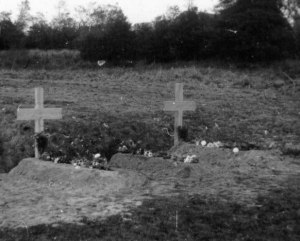
Crew graves: photo sent by Pastor Kristiansen to
Mrs Jean Cruickshank immediately after the War.
We protested to the Danish Foreign Ministry and to the Danish Red Cross. The Danish Civil Airdefence came to inspect the fallen sea-mines and they promised to protest at the German headquarters. Dr Best [the German administrator of Denmark], who shed a lot of precious Danish blood, gave the order that the bodies were to be transferred to the church-yard. On the 31st October the Germans came and dug the pilots up. We had coffins ready and a cosy corner in the church-yard.
They were buried in 4 white coffins. We were not allowed to go near when they dug the bodies up and they would not tell us when they were going to bury them; no ceremony was allowed and no prayer said.
That day we had a wedding party in the church and just as the wedding party left the church the Germans brought the first two coffins and we stayed just outside the church-yard until they had buried them all and we were not driven away. You may believe that many silent prayers were said..
The Germans put a wooden cross on the grave and the flowers from the first grave. On the wooden cross the Germans wrote 8 unknown American soldiers, but we have got only 7 names from the British Air Ministry. They ought not to have been unknown all of them as two of them had their clothes on and were not burned at all, the rest were more or less burned. We do not know what the Germans did to the papers and identity discs. The Germans came to the spot very quickly and we could not do much.
The grave has been nicely kept. Some people planted red, white and blue flowers making the Royal Air Force emblem and some other flowers and fresh flowers have been put on the grave every Saturday all through the Summer. Last winter and this winter again the grave has been covered with evergreens and looks very cosy.
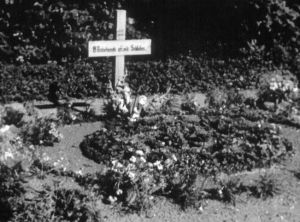
Another of Pastor Kristiansen's photos - note the
circular pattern of the RAF roundel
in the flowers in front of the cross
We have collected about £130 (2600 kroner) for a monument and a drawing of it has been sent to England and has been recognised. We hope to erect it in the Spring.
On the 15th October 1945 we had a memorial service in the church by the Canadian chaplain and myself, attended by a very big congregation. The chaplain and a British Officer did the honour at the grave. Their names were:
G. Arthur Hockin, Edmonton, Alberta
Flt Lt David Ballingall, Edinburgh
I have seen in the newspaper that the very first mother from England has visited her son's grave in Denmark. Everybody connected with that gallant crew will always be very welcome here.
On Christmas Eve, just after our service in the church we brought one of the Christmas trees from the church and planted it on the grave but we could not light the candles as the wind was blowing too hard. We sang some Christmas hymns and I recited a verse much used in these years but written about our dead soldiers in the war against Germany 1848-50:
| Guds Fred med vor døde I Danmarks Rosengaard, Guds Fred med dem som bløde Af dybe Hjertesaar! |
The peace of God with our dead ones In the Rose Garden of Denmark, The peace of God with all who bleed From deep heart wounds! |
The good message from St Luke chapter 2 was said:
"For behold I bring you great tidings of good joy, which shall be to all people. For unto you is born this day in the city of David a Saviour, which is Christ the Lord."
The relatives in far away countries sorrowing for their dear ones were of course remembered in our prayers. It was bitterly cold but a very moving ceremony in the cold night.
It may interest you to know a little about ourselves (wrote Dean Kristiansen):
My wife, 42 years of age, was born in Calcutta, her father was a missionary among the Santals. I am 49 years of age. I have for 12 years been a missionary in Assam among the Boros and have baptised a good number of them, built 3 mission stations, dedicated more than 20 churches, translated the New Testament and the National Anthem into Boroni and written several books in the vernacular. I have become an honorary member of the British and Foreign Bible Society.
I have enjoyed to live under the Union Jack and I have several good English friends. Our first son is buried in Darjeeling in India. In 1939 we returned to Denmark, in 1940 I became vivar for two churches, Laastrup and Skals and in 1943 I became Provost, what you call Dean, for 31 churches.
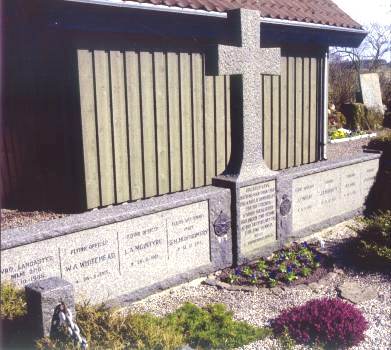
The crew memorial grave in 2001. Approaching the church, it is on the
left.
panels L-R: Avro Lancaster MEM 15.10.44: Flying Officer WA Whitehead
28.8.15
Flying Officer LA McIntyre 28.6.1915, Flight Lieutenant Pilot GH
Montgomery 12.12.1914:
central panel (see below): Flight Sergeant J Findlay 6.11.21: Sergeant
JR Marriott
Sergeant AF Hall, Sergeant JD Cumming: copyright Jens Frandsen Viborg
Stifts Folkeblad
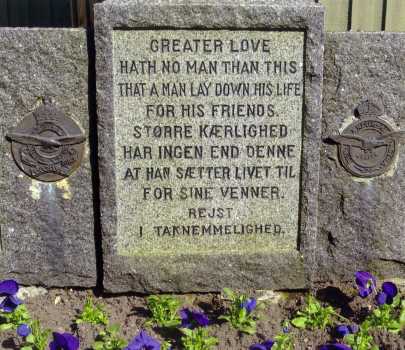
Dedication panel of the crew memorial in Låstrup Churchyard, 2001
copyright Jens Frandsen Viborg Stifts Folkeblad
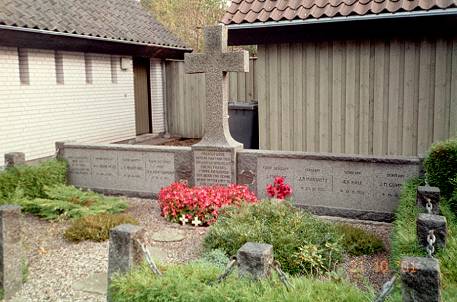
At rest, cared for and remembered
21st October 2001, a few days after the anniversary of their deaths
(with thanks to Arne Sindberg)
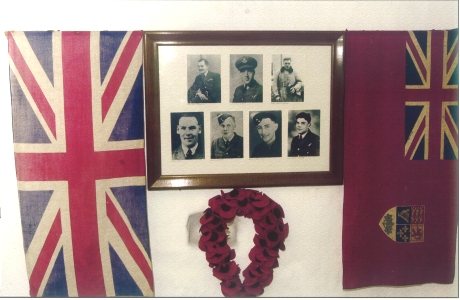
The memorial to the Montgomery crew in Låstrup Church, 2001.
top L-R: Montgomery, ?McIntyre, ?Whitehead
2nd row L-R: ?, Marriott, ?, Cumming
copyright Jens Frandsen Viborg Stifts Folkeblad
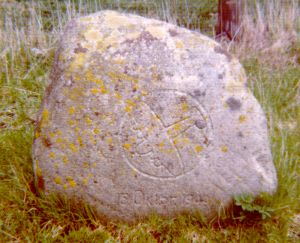
Carved into this boulder is the shape of a four engined bomber
and the date 15 October 1944. It marks where the aircraft fell.
(Cruickshank)
A version offered by residents who witnessed the events given to J D Cruickshank on a visit to the town in 1978:
'The plane came over, made the mines safe, and dropped them by parachute clear of the village.
The plane crashed and bodies were scattered around.The Germans were kicking the bodies and wouldn't let anyone near them. A day or two later the Germans buried them in rough graves.
In later years they were reburied in the Churchyard and a memorial erected.
Their photos are in a separate memorial inside the Church. To this day the graves are attended by the local Schoolchildren.'
Lynden McIntyre was the son of Peter Daniel and Mary Ann McIntyre: husband of Marjorie McIntyre of Ottawa, Ontario, Canada.
James Marriott was the son of Lt Albert Charles Marriott and Florence Eveline Marriott of Leicester.
Albert Hall was the son of George Albert Hall and Mary Hall (nee Dalton), of Marske, Yorkshire.
James Cumming was the son of James and Annie Cumming, of Falkirk, Stirlingshire; nephew of Jean Cruickshank of Bainsford, Falkirk, Stirlingshire.
Further research
According to the Commonwealth War Graves Commission, Låstrup is a village in Central Jutland about 15km north of Viborg and about half a kilometre east of the N533 from Viborg to Logstor. Travelling north from Viborg, turn right at the road signposted to Låstrup and the church can be seen on the right hand side. The dark granite private memorial comprising a central cross and eight inscribed panels can be seen on the left hand side 15 metres from the churchyard gate.
7 or 8 men buried?
On 18th April 2001 the Commonwealth War Graves Commission provided the following information in response to the editor's query about whether there are 7 men (as we would expect from RAF records) or 8 men (as the Germans appear to have thought) buried in Låstrup, which the CWGC describe as a collective grave:
"To answer your query about the graves in Laastrup Churchyard very simply, there was never an eighth person on the plane and all our records indicate just the seven man crew buried and commemorated in the churchyard." ... "We have just completed a revision of all our register introductions for Denmark (unfortunately, it will be some time before these appear on our web site) and this quite clearly states seven men buried in the cemetery."
The memorial in the churchyard has seven crew name panels. The eighth panel refers to their Avro Lancaster.
Jim Cumming's cousin, Mr J D Cruickshank, and his family, are researching Jim's service, the events connected with the loss of his aircraft and the commemoration of the crew by the village of Låstrup.
He remembers that he told him that he shot down a doodlebug whilst flying back home from a raid. A list of operations done by the crew has been provided to the family.
The recently published 207 Squadron History refers to the 'doodlebug incident' thus:
Fifteen aircraft were sent to Stuttgart on 28/29 July, and Wg Cdr J F Grey claimed that his crew had destroyed two enemy fighters. Flg Off D Grant topped that by claiming three and Flg Off G H Montgomery claimed two fighters and a 'doodlebug'.
In 1978 the Cruickshank family donated three sketches of the city of York to Låstrup School as a token of gratitude for the care the schoolchildren took of the crew's graves. They hope to return to Låstrup.
Contacts are welcomed from the people of Låstrup and from anyone who knew of members of the crews mentioned or their families:
Jakob Thorup Thomsen, Viborg Stifts Folkeblad : response to his articles on the crash
A German soldier secretly asked two 12 year old boys to put flowers into two of the coffins.
It happened when the airmen were reburied. At first the airmen were buried in the field without coffins. The people in Laastrup put a lot of flowers on the graves, and the German soldier was one of several soldiers who had the job of moving the bodies to the churchyard.
The other soldiers were at the churchyard at that time and the German soldier was alone in the field together with the two last coffins. It was his job to put the flowers into the empty graves, but he asked the boys, who were playing very close to the field, to remove the top of the last coffins and fill them with flowers. Then they closed the coffins again so no one could find out, what they had done.
If you live in Låstrup or the area and have an interest in these events, it would be much appreciated if we could have donations of good photos of the marker and of identified individual crew members from the memorial in the church, and any other images or information that will add to this story.
Please contact the editor, who will pass them on to the Cruickshank family.
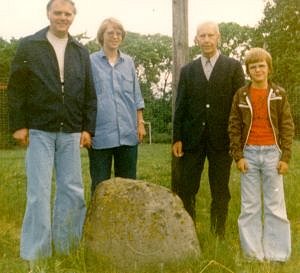
L-R : Mr J D Cruickshank (cousin of Jim Cumming); translator Karen who
was a teacher
at Låstrup School, her husband Peter was a farmer: man, name not
known, who was an
eyewitness of the crash and who was headmaster of the school in 1944;
Rod Cruickshank.
| Now again I have been on a trip
to Laastrup and met with my contact person, as I have
explained to you he is 85 years old, but still mentally fit.
I guess, we talked for about half an hour about the crash in
1944. He told the following story: The aircraft came from the west in a very low altitude over the village, and several things had already fallen off the aircraft before it hit the ground. The aircraft burned most of the night, and several explosions from the ammunition on board could be heard. The morning after the Germans came and the area was closed, but he told that from the distance it could be seen that the crew were buried with no coffins. He also told that he saw a German soldier walking away with a little blue child's dress under his arm. No doubt he has taken it from a crewmember as spoils of war. Have you heard about this little incident before? A few days later the bodies were dug up by German soldiers and placed in coffins. They were then buried in the cemetery, but without any kind of ceremony. He told that the German soldier had their lunch packet on the grave after completion of the work. He also told, a few days later he found a first aid box, which he handed over to the local doctor/GP. Further he told that the Germans drove 4 lorry loads away from the wreck. The rest was dug into the ground on location. My contact person had a few souvenirs, which he gave me. I will take pictures of them when I get the time and send the pictures to you (on one of the items you will find the production number, so maybe one can figure out where on the plane it has been placed.) |
Jeg har nu igen været en tur i
Laastrup og hilst på min kontaktperson, som jeg har fortalt
er han 85 år, men stadig helt kvik. Vi snakkede vel en halv
times tid om nedstyrtningen i 1944. Han fortalte
følgende: Flyet kom fra vest i meget lav højde ind over byen, og flere ting var allerede faldet af flyet inden den ramte jorden. Flyet brændte det meste af natten, og der lød mange knald fra ammunition om bord. Morgenen efter kom tyskerne og der blev afspærret, men han fortalte at han på afstand kunne se besætningen blive begravet uden kister. Han fortalte også, at han så en tysk soldat gå med en lille blå barnekjole under armen, som han helt sikkert havde taget fra et besætningsmedlem som krigsbytte. Har I hørt om den lille episode før? Nogle dage efter blev ligene gravet op af tyske soldater og lagt i kister. De blev så begravet på kirkegården, men uden nogen form for ceremoni. Han fortalte at han så de tyske soldater spise deres madpakker på graven efter arbejdet. Han fortalte også at han nogle dage efter fandt en forbindskasse, som han overlod til egnens læge. Også fortalte han at tyskerne kørte 4 lastbillæs væk fra vraget. Resten blev gravet ned på stedet. Min kontaktperson havde et par souvenir, som jeg fik med. Jeg vil fotografere dem når jeg får tid og så skal jeg nok sende billeder til dig ( på en af tingene er der et fabrikationsnummer, så måske kan der findes ud af hvor det har siddet i flyet). |
research in February 2002 by Arne Sindberg, Viborg: translation by Lorenz Andersen, UK
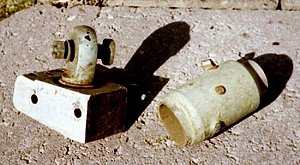 |
April 2002: Items of wreckage from LM208 referred to by Arne
Sindberg. The item on the left has 41E1044 engraved on it. The item on the right is 7 cm long. What are they please? |
More information on the fate of this crew can be seen on the Airwar over Denmark website
Contacts
207 Squadron RAF History website editor, Frank Haslam
for the following replace AT with @ before sending
Rod Cruickshank : cruickshank_rodAThotmail.com
Steve Cruickshank : Steve.CruickshankATuk.nestle.com
Jakob Thorup Thomsen, Viborg Stifts Folkeblad: jakob.thorup.thomsen.vsfATde-bergske.dk
To return to the website you came from
please close this window by clicking
the X in the top right hand corner of your screen.
Royal Canadian Air Force
 |
The Maple Leaf ProjectMaking photographs of Canadian and Newfoundlander 20th century war graves accessible for the families who have never seen the resting place of their fallen. |
please click your Back icon to return to the text
207 Squadron Royal Air Force History
This page was last updated on 24 Oct 2007: 17 Nov 17